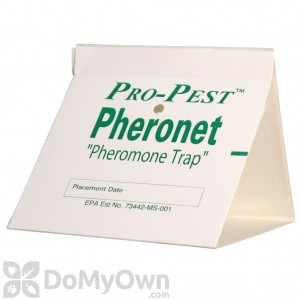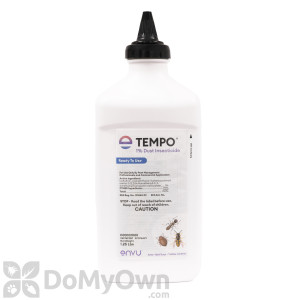Inspection
You are likely reading this article because you have noticed the presence of small moths in your kitchen and pantry over a period of weeks or months. The first step in solving a pantry pest problem is to discover the source (or sources) of infestation. You should conduct a thorough inspection of the infested area with a good flashlight and magnifying glass.
Be sure to inspect all food items, corners, and crevices in the infested area. Foodstuffs should actually be poured out of their packages and sifted through one by one. You will be looking for any sign of living pests or potential larva (creamy white ‘wormlike' pests with a brown head). Detection of either of these will indicate where to further focus your control efforts if needed.
What it looks like
The Indian Meal Moth has a wing span of about 5/8 inch, and are more colorful than a common grain moth with the outer one-third covered in reddish-copper scales. The hind wings are gray. Larvae look like white worms with brown heads.
Signs of Indian Meal Moth infestation include the following:
- Clumpiness of infested foods. This is the most indicative sign of Indian Meal Moth infestation. Clumps in the infested food are formed by groups of larva that are webbed together with strands of silk.
- Small moths flying around the kitchen or home in a zigzag pattern. Indian Meal Moths fly mostly at night and are attracted to lights.
- Larva (white wormlike pests with brown heads) suspended from the ceiling. Larva occasionally crawl up walls and suspend themselves from a silken thread. This is where you would use your magnifying glass and get up close because the larva are small and would be difficult to see from the ground.
Feeding Preferences
Indian Meal Moth feeding preferences include grain products, dried fruits (especially figs), powdered milk, seeds, nuts, graham crackers, chocolate and candies, bird seed, dried red peppers, dehydrated dog food, etc.
If you are unsure about an item being infested, test it! Place any and all potentially infested materials in a heavy duty ziploc bag for at least a month. If you find the pantry pest accumulating in the bag, you know the foodstuff is contaminated and needs to be discarded.
Control Measures
There are three different kinds of control measures for Indian Meal Moths, and all are essential to completely eliminate the problem.
1)Non-Chemical Control
2) Traps
3) Chemical Control/ Crack & Crevice Spray
1) Non-Chemical Control
As effective as pesticides are, it is not reasonable to think they will achieve total elimination of Indian Meal Moths without any effort on your part. Practicing good sanitation and eliminating conditions that favor Indian meal Moths will speed the work of chemical control and prevent future infestations from returning.
- Remove dry and bulk foods from original containers and store them instead in tight-fitting containers. (Pasta, cereal, flour- anything that comes in a paper or cardboard box)
- Clean pantry shelves regularly to remove small bits of food that Indian Meal Moths need to survive.
- Never purchase broken or damaged packages. The chance of these being infested is greater than for perfectly sealed ones.
- Never mix old and new lots of foodstuffs. If the old material is infested, the Indian Meal Moths will quickly invade the new.
- Clean old containers with hot soapy water before filling them with fresh food. Containers may be contaminated and cause a new infestation.
- Keep storage units dry. Moisture favors the development of Indian Meal Moths; dryness discourages them.
2) Traps
Pantry Pest Traps represent a simple and effective solution for getting rid of Indian Meal Moths and other product pests in kitchens, pantries, bathrooms, warehouses, and food processing plants.
How Traps Work. Indian Meal Moth Traps and pantry pest traps are generally constructed of cardboard or paper lined on the inside with pheromone impregnated glue strip. Insect sex pheromones powerfully attract the male moths, trapping and killing them. Thus, mating is disrupted to the point of eventual control.
We recommend ProPest Pheronet Pantry Pest Trap or Revenge Pantry Pest Traps
Trap Set-Up. Both of the above traps are very simple to use. Simply remove the release paper on the trap to expose the glue. Form the trap into a box form and hang it in areas of moth activity. The trap can be hung with a hook or hanger or secured to a wall or other surface with double-sided tape. Each trap has an active life of 4 to 6 weeks.
3) Chemical Control
After you have conducted your inspection and before placing food items back on newly cleaned shelves, now is a good time to apply a crack and crevice spray around the perimeter of your pantry and shelving. This will help prevent Indian Meal Moths from infesting future food packages.
Effective Crack & Crevice Sprays for Indian Meal Moths:
CB-80 Extra Aerosol - 17 oz. can
Microcare Aerosol - 20 oz. can
Or save money with the Pantry Pest Kit:
Pantry Pest Kit
View our entire line of Pantry Pest Control products
View our entire line of Pantry Moth Control products
Related Articles:
Indian Meal Moth Identification & Biology
Indian Meal Moth Traps
Get Rid of Meal Moths
Pantry Pest FAQ





